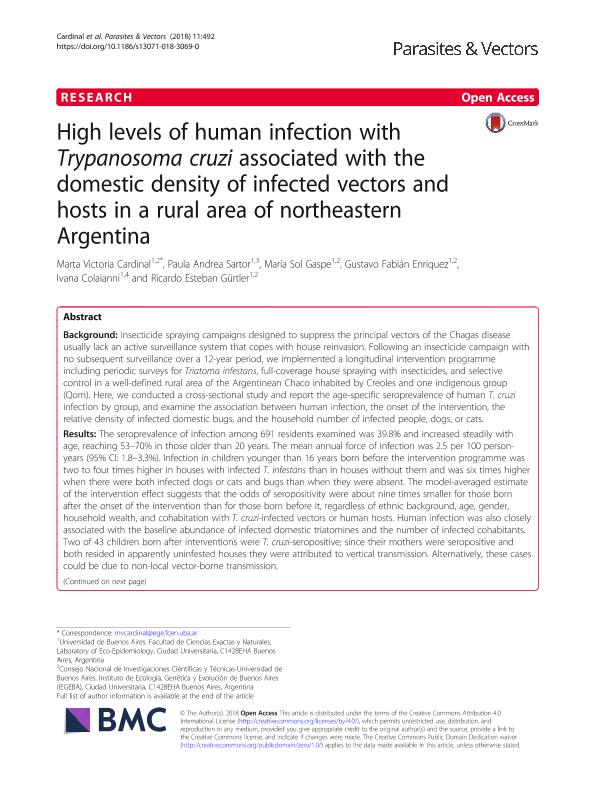Mostrar el registro sencillo del ítem
dc.contributor.author
Cardinal, Marta Victoria

dc.contributor.author
Sartor, Paula Andrea

dc.contributor.author
Gaspe, Maria Sol

dc.contributor.author
Enriquez, Gustavo Fabián

dc.contributor.author
Colaianni, Ivana
dc.contributor.author
Gurtler, Ricardo Esteban

dc.date.available
2020-02-03T20:15:16Z
dc.date.issued
2018-08
dc.identifier.citation
Cardinal, Marta Victoria; Sartor, Paula Andrea; Gaspe, Maria Sol; Enriquez, Gustavo Fabián; Colaianni, Ivana; et al.; High levels of human infection with Trypanosoma cruzi associated with the domestic density of infected vectors and hosts in a rural area of northeastern Argentina; BioMed Central; Parasites and Vectors; 11; 492; 8-2018; 1-13
dc.identifier.issn
1756-3305
dc.identifier.uri
http://hdl.handle.net/11336/96578
dc.description.abstract
Background: Insecticide spraying campaigns designed to suppress the principal vectors of the Chagas disease usually lack an active surveillance system that copes with house reinvasion. Following an insecticide campaign with no subsequent surveillance over a 12-year period, we implemented a longitudinal intervention programme including periodic surveys for Triatoma infestans, full-coverage house spraying with insecticides, and selective control in a well-defined rural area of the Argentinean Chaco inhabited by Creoles and one indigenous group (Qom). Here, we conducted a cross-sectional study and report the age-specific seroprevalence of human T. cruzi infection by group, and examine the association between human infection, the onset of the intervention, the relative density of infected domestic bugs, and the household number of infected people, dogs, or cats. Results: The seroprevalence of infection among 691 residents examined was 39.8% and increased steadily with age, reaching 53-70% in those older than 20 years. The mean annual force of infection was 2.5 per 100 person-years (95% CI: 1.8-3.3%). Infection in children younger than 16 years born before the intervention programme was two to four times higher in houses with infected T. infestans than in houses without them and was six times higher when there were both infected dogs or cats and bugs than when they were absent. The model-averaged estimate of the intervention effect suggests that the odds of seropositivity were about nine times smaller for those born after the onset of the intervention than for those born before it, regardless of ethnic background, age, gender, household wealth, and cohabitation with T. cruzi-infected vectors or human hosts. Human infection was also closely associated with the baseline abundance of infected domestic triatomines and the number of infected cohabitants. Two of 43 children born after interventions were T. cruzi-seropositive; since their mothers were seropositive and both resided in apparently uninfested houses they were attributed to vertical transmission. Alternatively, these cases could be due to non-local vector-borne transmission. Conclusions: Our study reveals high levels of human infection with T. cruzi in the Argentinean Chaco, and the immediate impact of sustained vector surveillance and selective control actions on transmission.
dc.format
application/pdf
dc.language.iso
eng
dc.publisher
BioMed Central

dc.rights
info:eu-repo/semantics/openAccess
dc.rights.uri
https://creativecommons.org/licenses/by-nc-sa/2.5/ar/
dc.subject
CATS
dc.subject
CHAGAS DISEASE
dc.subject
DOGS
dc.subject
ECO-EPIDEMIOLOGY
dc.subject
GRAN CHACO
dc.subject
SEROPREVALENCE
dc.subject
TRIATOMA INFESTANS
dc.subject.classification
Parasitología

dc.subject.classification
Ciencias de la Salud

dc.subject.classification
CIENCIAS MÉDICAS Y DE LA SALUD

dc.title
High levels of human infection with Trypanosoma cruzi associated with the domestic density of infected vectors and hosts in a rural area of northeastern Argentina
dc.type
info:eu-repo/semantics/article
dc.type
info:ar-repo/semantics/artículo
dc.type
info:eu-repo/semantics/publishedVersion
dc.date.updated
2019-10-09T20:42:38Z
dc.journal.volume
11
dc.journal.number
492
dc.journal.pagination
1-13
dc.journal.pais
Reino Unido

dc.journal.ciudad
Londres
dc.description.fil
Fil: Cardinal, Marta Victoria. Consejo Nacional de Investigaciones Científicas y Técnicas. Oficina de Coordinación Administrativa Ciudad Universitaria. Instituto de Ecología, Genética y Evolución de Buenos Aires. Universidad de Buenos Aires. Facultad de Ciencias Exactas y Naturales. Instituto de Ecología, Genética y Evolución de Buenos Aires; Argentina
dc.description.fil
Fil: Sartor, Paula Andrea. Universidad de Buenos Aires. Facultad de Ciencias Exactas y Naturales; Argentina. Universidad Nacional del Nordeste; Argentina
dc.description.fil
Fil: Gaspe, Maria Sol. Consejo Nacional de Investigaciones Científicas y Técnicas. Oficina de Coordinación Administrativa Ciudad Universitaria. Instituto de Ecología, Genética y Evolución de Buenos Aires. Universidad de Buenos Aires. Facultad de Ciencias Exactas y Naturales. Instituto de Ecología, Genética y Evolución de Buenos Aires; Argentina
dc.description.fil
Fil: Enriquez, Gustavo Fabián. Consejo Nacional de Investigaciones Científicas y Técnicas. Oficina de Coordinación Administrativa Ciudad Universitaria. Instituto de Ecología, Genética y Evolución de Buenos Aires. Universidad de Buenos Aires. Facultad de Ciencias Exactas y Naturales. Instituto de Ecología, Genética y Evolución de Buenos Aires; Argentina
dc.description.fil
Fil: Colaianni, Ivana. Universidad de Buenos Aires. Facultad de Ciencias Exactas y Naturales; Argentina. Gobierno de la Ciudad de Buenos Aires. Hospital de Agudos "D. F. Santojanni"; Argentina
dc.description.fil
Fil: Gurtler, Ricardo Esteban. Consejo Nacional de Investigaciones Científicas y Técnicas. Oficina de Coordinación Administrativa Ciudad Universitaria. Instituto de Ecología, Genética y Evolución de Buenos Aires. Universidad de Buenos Aires. Facultad de Ciencias Exactas y Naturales. Instituto de Ecología, Genética y Evolución de Buenos Aires; Argentina
dc.journal.title
Parasites and Vectors

dc.relation.alternativeid
info:eu-repo/semantics/altIdentifier/url/https://parasitesandvectors.biomedcentral.com/articles/10.1186/s13071-018-3069-0
dc.relation.alternativeid
info:eu-repo/semantics/altIdentifier/doi/http://dx.doi.org/10.1186/s13071-018-3069-0
Archivos asociados
